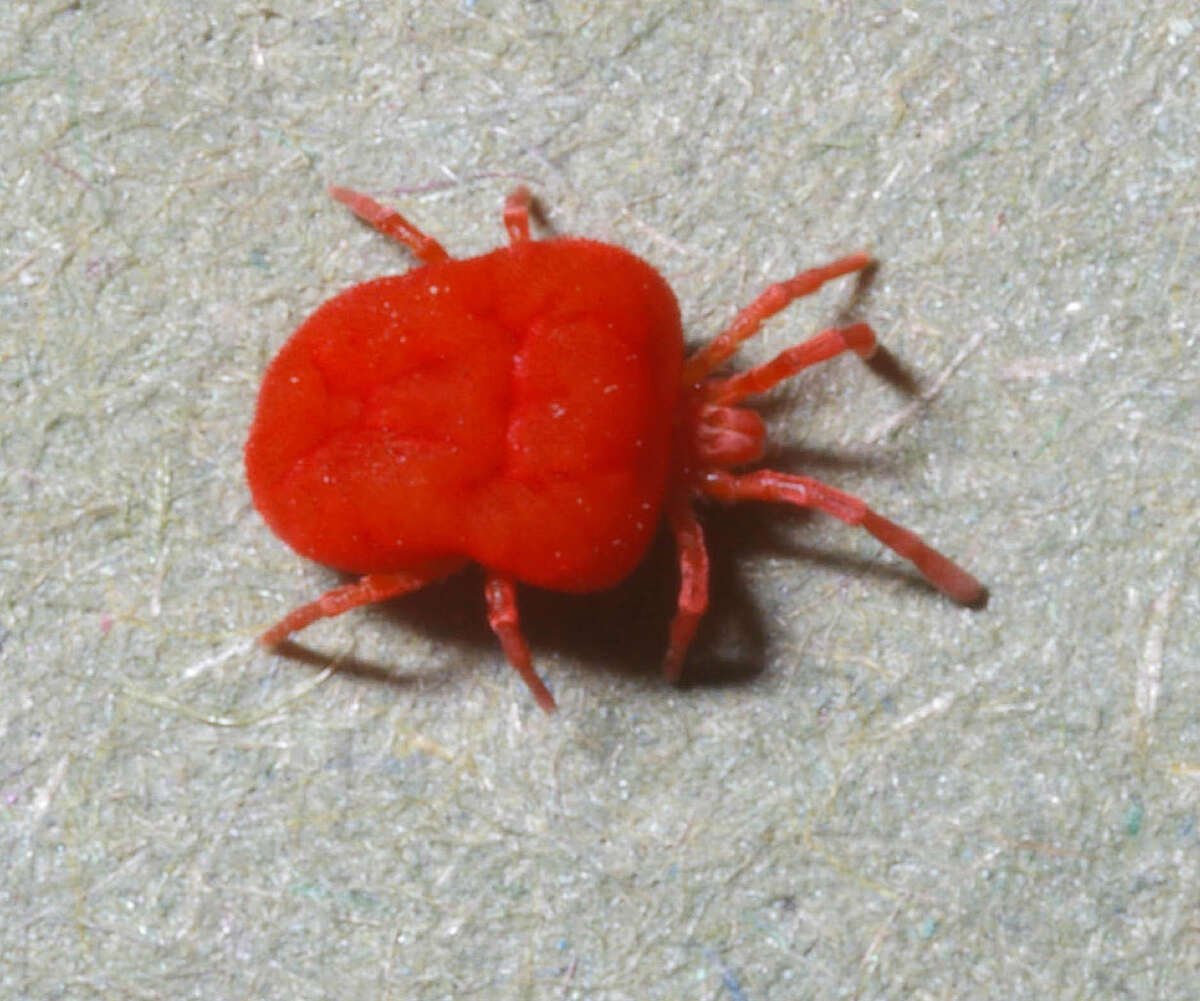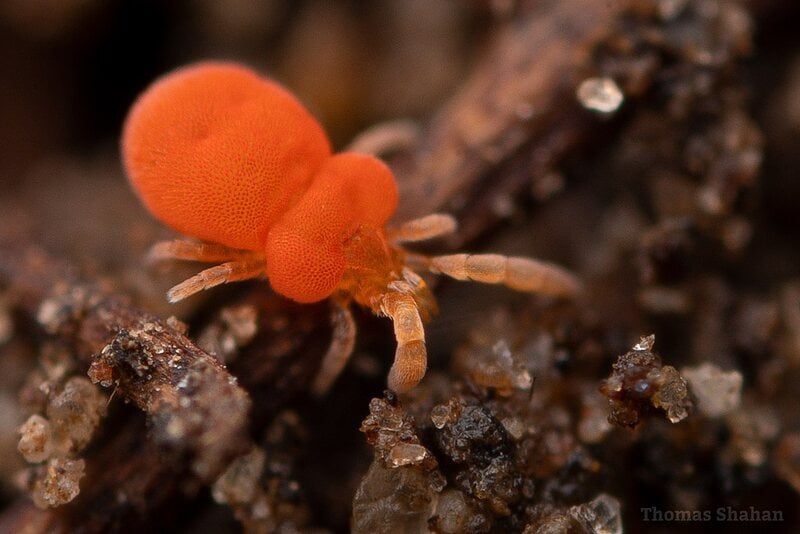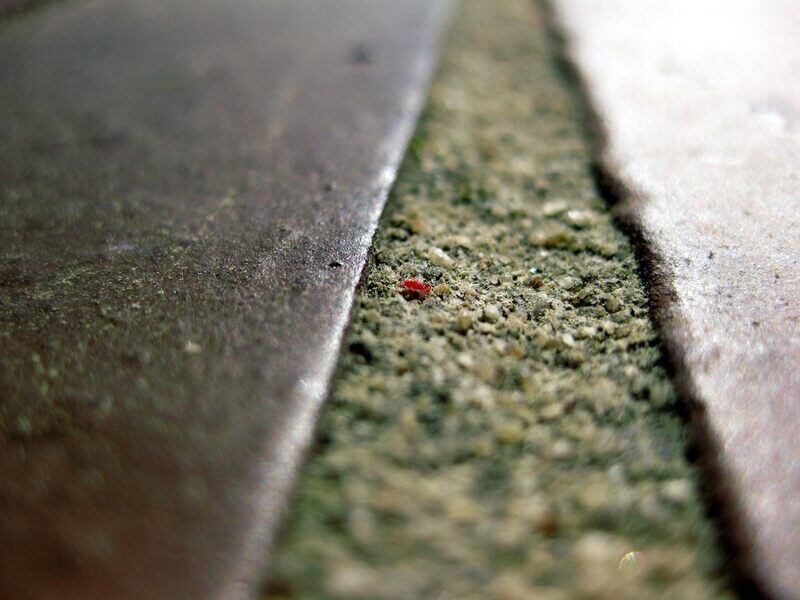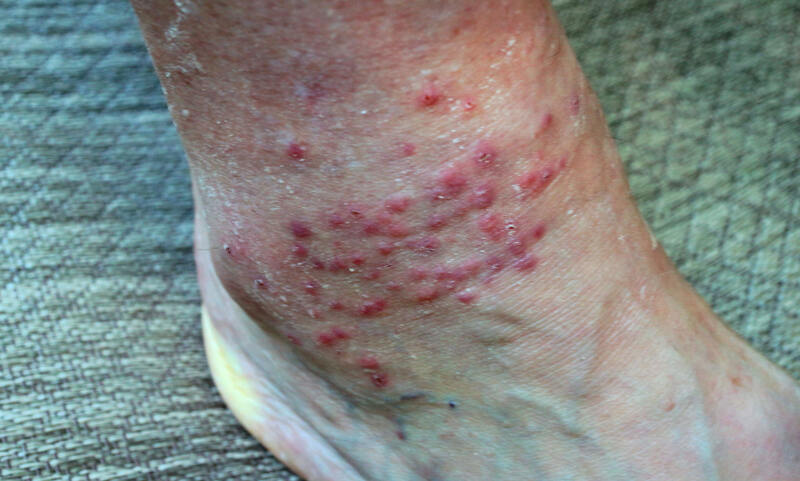
Have you ever had a fun day outside, only to find your ankles covered in itchy red bumps? You may have encountered chiggers — tiny bugs that have a fondness for human skin and often bite without being noticed. Fortunately, there are ways to get rid of chiggers in your yard and treat their bites. From simple lawn care methods to inorganic chemicals, we’ll show you how.
What Are Chiggers?

Chiggers are microscopic mites whose bites cause intense itching and reddish welts. It’s a myth that they burrow under the skin and drink blood, but these troublesome bugs still cause a nuisance by feeding on skin cells and hiding in grassy areas of your yard.
A magnifying glass is necessary to spot chiggers because they are hard to see with the naked eye. They can feed on human hosts for up to four days and can survive in your yard for months while waiting for a host.
Also known as red bugs, berry bugs, or harvest mites, chigger mites favor humid climates and love to lurk in wooded areas, tall grass, and unkempt weeds. Only chigger larvae bite, after which the nymphs and adult chiggers feed on insects and fellow arachnids.
So, how do you get rid of chiggers? Here are the best ways to get rid of chiggers in your lawn.
How to Get Rid of Chiggers Naturally

You have options for getting rid of chiggers in the yard. However, the best way to get rid of chiggers is with natural methods and preventative measures. Inorganic chemical treatments can disrupt the health of your lawn.
Here is how to get rid of chiggers in your yard naturally.
Improve Air Circulation
Practicing proper lawn care has several benefits, including preventing and getting rid of chigger infestations. Improving air circulation in your yard with regular lawn care can help reduce moisture buildup and deter chiggers.
- Cut your grass. Chiggers thrive in tall grass and vegetation, so regularly mowing your lawn the right way can help reduce their habitat. Wear long pants tucked into your socks to protect yourself from bites while mowing.
- Aerate your lawn. As chiggers prefer damp, shady areas, aerate your lawn to improve air circulation and sunlight exposure.
- Maintain your landscape. It’s crucial to trim bushes, remove unnecessary vegetation, and control weeds in your yard. Chiggers can hide in these areas, so clearing them out can minimize their presence.
- Remove debris. Clearing debris can help reduce your chigger problem. Use gloves and protective clothing when handling these materials to avoid any contact with chiggers, or consider the cost of a junk removal service to save you the hassle.
Keep Host Animals Out
Chiggers can thrive with a steady supply of host animals, including small mammals like squirrels and rats. Birds can also be carriers. To keep these critters away from your yard, check for and get rid of rodents taking refuge under your deck or porch.
Done checking under the hood? Cut off potential water and food sources like these:
- Empty flower pots and buckets
- Bird baths and feeders
- Trash cans
- Unfenced garden plots (section these off with a garden border or a small-space fence to prevent pests)
- Unsealed compost bins
Sprinkle Diatomaceous Earth
Diatomaceous earth is an organic pesticide that is highly effective for controlling yard pests. By sprinkling a small amount (approximately 5 pounds per thousand square feet) across your yard, you can dry out chiggers in the grass and eliminate them, restoring your yard to a pest-free landscape.
Diatomaceous earth is a versatile product that can be sprinkled dry in a ring around the affected area to isolate it, as well as along the perimeter of your yard.
To use diatomaceous earth for chiggers, follow these steps:
- Purchase food-grade diatomaceous earth from a garden supply store or online.
- Ensure that the affected area is dry before applying diatomaceous earth.
- Wear protective gloves, goggles, and a dust mask to avoid inhaling the fine particles.
- Sprinkle a thin layer of diatomaceous earth directly onto the infested areas and hot spots in your yard, paying close attention to places where chiggers are likely to hide, such as tall grass and vegetation.
- Reapply diatomaceous earth after rainfall or irrigation to maintain its effectiveness.
- Avoid applying diatomaceous earth to blooming plants, as it may harm beneficial insects.
- Keep children and pets away from treated areas until the diatomaceous earth has settled and dried.
To create a chigger spray for the yard, you can dissolve diatomaceous earth in water (approximately 4 tablespoons per gallon) to create a spray that will help it adhere to hard-to-reach areas.
Note: Diatomaceous earth can also kill beneficial insects. To ensure it eliminates only chiggers, target the affected areas instead of spreading it across the entire yard, and cover those areas with a tarp for a few days before application.
How to Get Rid of Chiggers with Inorganic Chemicals
If you have severe infestations, a chemical chigger treatment for the yard can help. However, you should combine it with good lawn care practices and other natural pest control to keep the chiggers away for good.
Lawn treatments for chiggers often include the following active ingredients:
- Bifenthrin
- Carbaryl
- Cyfluthrin
- Cyhalothrin
- Diazinon
- Malathion
- Permethrin
Methods for eliminating chiggers with inorganic chemicals:
- Use a chigger-specific insecticide spray: Apply to areas where chiggers are likely found, like tall grass, vegetation, and shaded areas.
- Apply a broad-spectrum insecticide: Use if you have a severe chigger infestation or other pest problems, like fleas, in your yard.
- Consult a professional pest control service: Seek their help for persistent chigger problems or if unsure about using chemicals.
Always read and follow label instructions for any chemicals or DIY pest control used. Take safety precautions and consider the environmental impact.
How to Prevent Chigger Bites

While you’re trying to kill chiggers in the yard, you’ll want to know how to avoid those painful itchy welts they leave behind. Follow these tips to protect yourself:
1. Wear protective clothing like long sleeves, long pants, and closed-toe shoes when spending time in areas with known chigger infestations. Tucking your pant legs into your socks can provide extra protection.
2. Apply insect repellents that contain DEET or oil of lemon eucalyptus (OLE) to exposed skin. Follow the instructions on the repellent for proper use and avoid applying DEET to clothing.
For clothing, protect yourself by using a permethrin spray. This insect shield kills chiggers, ticks, fleas, mites, black flies, lice, and mosquitoes.
3. Avoid walking in tall grass, vegetation, and densely wooded areas, especially during peak chigger activity times, such as in the early morning or late afternoon. The most common time of year to encounter chiggers is in the late spring and summer.
4. Take a hot shower and wash your clothes immediately after being in areas where chiggers may be present. Use warm water and soap to thoroughly clean your body and clothing, paying attention to areas where chiggers are likely to hide.
5. Try natural chigger repellents, such as essential oils like tea tree oil or lavender oil, to deter chiggers. Apply them to your skin or clothing as directed.
What Do Chigger Bites Look Like?
Chigger bites typically appear as red, itchy bumps on the skin. They are often found in groups or clusters and may resemble small blisters or welts. It’s common for chigger bites to be most noticeable around areas where clothing fits tightly, such as ankles, waistbands, and underarm areas.
Itching is caused by the digestive enzymes that larval chiggers produce. It can be intense and may last for several days. It’s important to avoid scratching the bites to prevent infection.
How to Treat Chigger Bites
Unfortunately, trying to get rid of chiggers in your yard can leave you dealing with bites.
If chiggers have bitten you and you are experiencing itching and discomfort, Cedars-Sinai recommends the following steps you can take to treat chigger bites:
- Avoid scratching: Although it may be tempting, scratching chigger bites can lead to further irritation and increase the risk of infection. Try to resist the urge to scratch the affected area.
- Wash the affected area: Use mild soap and warm water to gently cleanse the area with chigger bites. This can help remove any chigger remnants and reduce itching.
- Apply a cold compress: Using a cold compress or ice pack wrapped in a washcloth, apply it to the chigger bites for about 10-15 minutes. The cold temperature can help alleviate itching and reduce inflammation.
- Use over-the-counter creams or ointments: You can find over-the-counter anti-itch ointments, like hydrocortisone cream or calamine lotion, to relieve chigger bite symptoms. Follow the instructions on the packaging for proper use.
- Take an antihistamine: If the itching from chigger bites is severe and affecting your sleep or daily activities, consider taking an over-the-counter antihistamine. It can help reduce itching and promote comfort.
Note: Consult with a healthcare professional or pharmacist before taking any medication, especially if you have other health conditions or are taking other medications.
- Keep the affected area clean and dry: To prevent infection, it’s essential to keep the chigger bite area clean and dry. Avoid excessive moisture and apply a clean bandage if necessary.
- Seek medical attention if necessary: If chigger bite symptoms persist, worsen, or show signs of infection (such as increased redness, swelling, warmth, or discharge), it’s recommended to seek medical attention.
Pro Tip: Using nail polish to suffocate chiggers is ineffective, as they do not burrow into the skin.
FAQ About Chiggers
How Do You Know If You Have Chiggers?
The most noticeable indication of a chigger infestation is the presence of chigger bites. These itchy red bumps are commonly found in armpits and ankles and may initially resemble pimples, mosquito bites, or hives. However, they tend to grow larger over a few days and typically appear in clusters.
If you want to confirm that you are dealing with chiggers and not mosquitoes or another garden pest, you can try the following methods:
- Walk through your yard wearing long, protective white socks.
OR - Insert a piece of cardboard vertically into your grass.
If you observe tiny red mites attaching themselves to your socks or moving from the bottom to the top of the cardboard, it indicates the presence of chiggers.
Do Chiggers Go Away On Their Own?
Chigger bites will heal on their own after a couple of weeks, but removing these pesky pests from your yard will require some hands-on lawn care. If left alone, they can spread through your yard and survive for months while waiting for a host before they overwinter in the soil.
Can Chiggers Live In Your Bed?
Unlike bed bugs, chiggers cannot live on their own in your bed or your home. They need to latch onto a warm body to feast on constantly to develop into nymphs. However, they can stick around on human hosts for up to four days.
When to Call a Professional
Chiggers are troublesome pests that can wreak havoc on an otherwise peaceful lawn. If you’re itching to get rid of chiggers in your yard, don’t put yourself at risk of their painful itchy bites. Connect with a lawn care professional who will handle the overgrown grass and weeds in your yard, sending those chiggers packing.
Main Image Credit: Alan R Walker / Wikimedia Commons / CC BY-SA 3.0